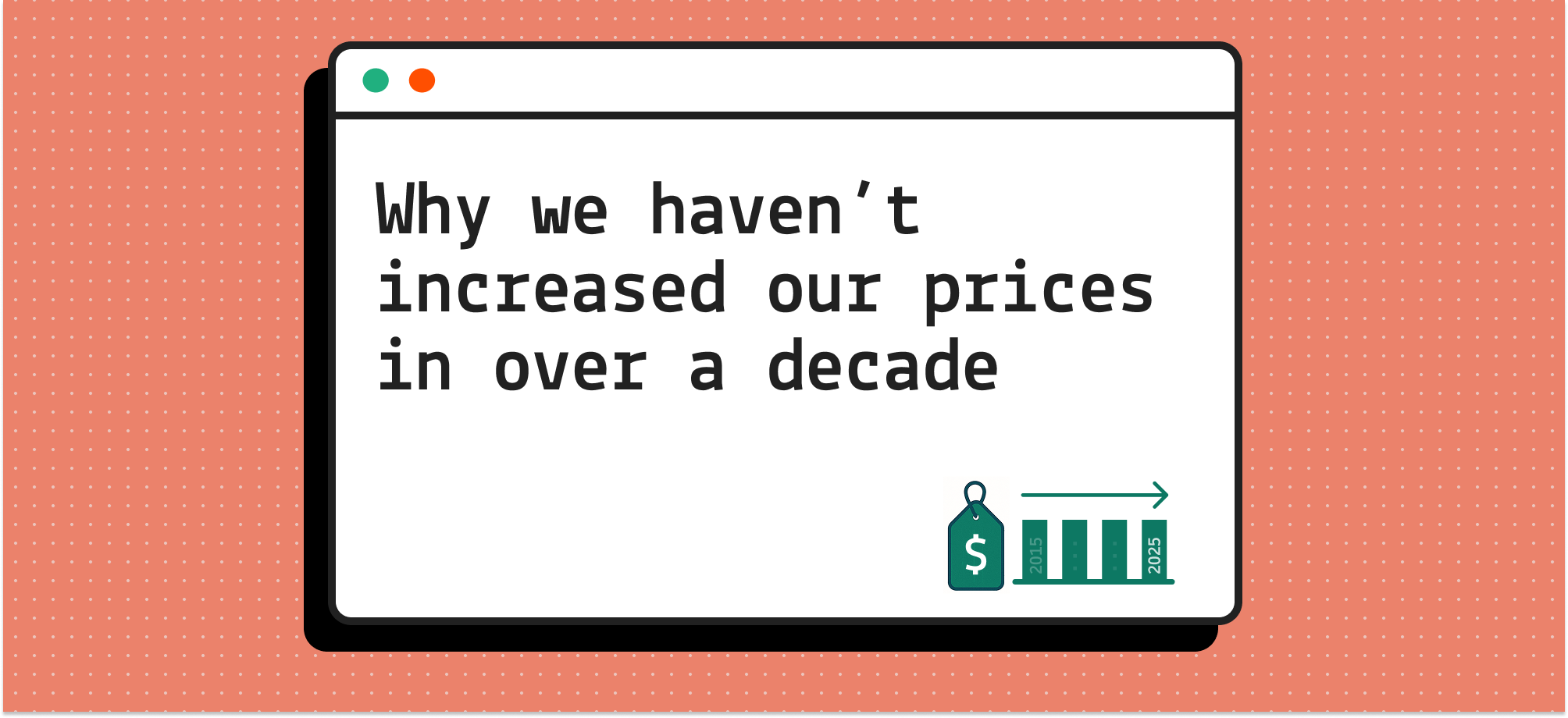Short.io recently turned 10.
For us, this is a time where we can reflect back on all our achievements and the lessons learned along the way.
One aspect of our service that consistently gets complimented is our pricing model. In truth, our ability to keep prices competitive has always been a conscious effort on our part. We want our users to have access to a great service at a great price — always.
This is why we’ve kept the prices the same since day one — fixed and affordable (in fact, we’ve even lowered our prices since we started).
But even though that’s a great goal to strive for, it’s not something that’s possible with just enthusiasm.
Consider this — you’re using a subscription service, and you’ve grown accustomed to it. It’s become a part of your life and your routine. One day, you get an email announcing your subscription is going to start costing more. Some companies only bump up their services with a dollar or two, but some raise prices to double or more of what they cost before. In another year or two, prices rise again.
That might be ok if it’s a service you love and use daily, or if it’s a service that was very cheap to begin with. A service you love using and want to support. Sometimes, things just become more expensive to run, and companies need to transfer part of that cost onto their users to remain in business.
But other times? It’s purely to increase margins.
To make our vision a reality, we knew we had to be strategic about this.
Here’s exactly what we did to earn our users’ trust.
Reason #1 — No investors
Many companies just starting out are faced with a choice:
Option 1:
Start out slow and risk financial difficulties in the short term. Companies who follow this approach need to exclusively focus on building momentum on their own, but the upside is that they can retain full control over their vision. It’s a fine, important, but difficult balance to achieve.
Option 2:
Gain the attention of investors and prop up your finances in the short term. This approach makes for a more effortless start, but it risks higher prices for customers and too much outside input from investors in the long run.
Really, even outside the link-shortening space, this is a complicated choice, and there’s no one best answer for every company. When you factor in additional complexity like hardware, the need to develop a real-world infrastructure from scratch, or aiming to launch in multiple markets at once, it’s important to empathize with the broader IT landscape.
At the same time, many investors and companies tend to be profit-driven from the start, putting income and shareholders at the forefront, instead of thinking of their users or improving their product.
As you can imagine, we went with the more challenging option 1. And with user after user and customer after customer, we were able to build the product you see today. The product we wanted. We’d be lying if we said it was easy, but we’re fully confident that it was worth it.
Circling back to the main point, this is one of the most important reasons we can keep our product competitive. We are not restrained by third parties.
Really, we consider being self-owned a privilege. It’s only possible thanks to our users. And we’re committed to making full use of that strength.
And speaking of users…
Reason #2 — A growing user base
We knew we had something special with Short.io, so we wanted to get it to as many people as possible.
And we had a plan.
To achieve this, we decided on prices that were affordable and scaled appropriately as the different tiers went up. We made a decision to keep prices low and not maximize income at the cost of our customers’ trust. This eventually allowed us to stand out and earn it.
We knew that if the user base grows, that would allow us to maintain these prices. Another important benefit is that we could keep other costs fixed. If the number of users doubled, we needed double the storage — but we didn’t need to pay twice for our office or for our existing employees, for example.
The less we charged our users, the more users we got. And the more users we got, the more realistic it was to charge users less.
That was the plan and that was exactly what happened.
It would have been very easy to just increase prices as time went on, boosting our margins for every user. Many — if not most — companies do just that.
But for us, it felt dishonest. We were still committed to providing a great service at a great price — no matter the cost.
Reason #3 — Open-source software
As developers, we believe in the power and importance of open-source software. These solutions are transparent, easy to scale, and often safer than their closed-source counterparts.
It also made sense from a cost perspective. Using open-source software allowed us to spend resources on more immediately important aspects of our product.
And of course, it could have allowed us to increase our margins at the expense of our users.
But we didn’t do that.
Our ethos was the same — keep transferring our savings onto our customers. Keep improving our product with thoughtful, useful features. Keep offering more for the same great price.
If you’re curious to know some of the open-source solutions we use (that also save costs), here’s our tech stack.
Timescale:
This is our time series database of choice, and we use it to store statistics related to Short.io
Kubernetes:
Google’s container orchestration system allows us to manage workflows; it runs directly on our servers and handles most of the system administration tasks for us
MySQL:
The database management system that works best for our use case
Cassandra:
We opted for this solution to store all our links
In total, these all come up to about 20TB of data being stored and processed. It’s an effective system that allows us the flexibility to manage your work and information on our platform effectively and efficiently. It saves us money, and it allows us to keep costs low for you.
Our promise to you
As a company, we made a decision. As regular, honest people, we’ve stuck to it.
For us, Short.io isn’t about increasing revenue, pandering to investors, or figuring how to squeeze out every last cent in an Excel spreadsheet.
We built this service because we wanted to democratize access to useful tools — tools that can help you launch your business, orchestrate your freelance career, or just allow you to keep track of things from time to time.
We made it as diverse and feature-rich as we wanted it to be; as diverse as our users could need. And we decided from the very start that we were going to get it in the hands of those who could make use of it.
In order to do that, we needed to set a realistic, competitive price. It isn’t a choice we were forced to make — it’s a decision we made with intent.
We truly believe in our product and we want as many people as possible to have access to affordable, effective link shortening.
We can’t promise that our prices will never change. Markets change and there can always be unforeseen complications.
But we promise that we’ll always do the best we can to provide you with the best service possible, for the lowest costs possible.
Here’s to another 10 years of affordable pricing.


